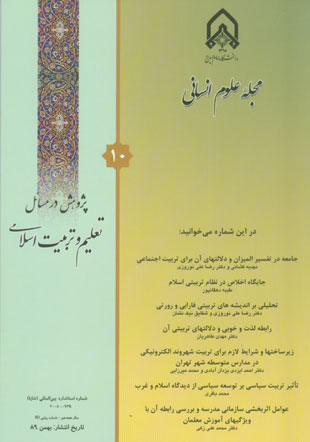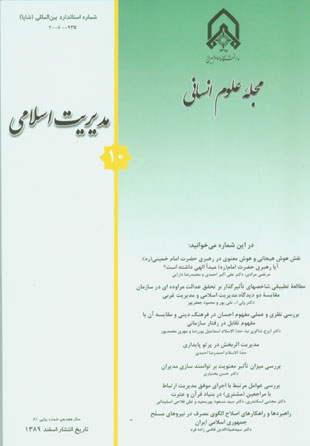فهرست مطالب

مجله علوم انسانی
پیاپی 80 (بهمن 1389)
- پژوهش در مسائل تعلیم و تربیت اسلامی
- 210 صفحه، بهای روی جلد: 20,000ريال
- تاریخ انتشار: 1389/12/01
- تعداد عناوین: 10
-
-
فراخوان مقالهصفحه 195
-
صفحه 196
-
صفحه 203
-
Page 7This research is intended to clarify Allameh Tabatabaee’s view on society and its educational indications. Descriptive and analytical methods are applied to investigate the issue. There are two general approaches regarding societies. According to the first approach, societies do not have independent identities. Their identities are the same as that of the their members. Based on the second view, however, societies include people with powerful personal identities. According to this view, the whole power of society ismore than the collection of its members. Accepting the second view, Allameh Tabatabaee has based his idea on the importance and authenticity that are given to society in the Holy Quran. Referring to various levels and characteristics of the society, he presents characteristics and requirements that different societies have had throughout history. He believes that societies, like human beings, move on a changing and developmental spectrum. All these findings, emphasizing on the importance and status ofsocial education, necessitate that policymakers consider social education of the individuals, which is an effective factor in the social improvement, more seriously. The educational approach of Allameh Tabatabaee includes companionship, constructive competence, deprivation, and reward and warning.
-
Page 33Sincerity is the most gracious level of behavior, which can pave the way for reaching to the highest moral degree. As sincerity is the integration of all goodness, and the healing of all moral evilness, it can be regarded as the most important means of individual and social revival. Furthermore, it can be considered as the basis of utopia (ideal state). As the first step, it is necessary to recognize the term sincerity in the way of God’s command, and then consider educational steps to achieve it. As the final step, a practical educational mechanism is presented to overcome hindrances in the way ofachieving sincerity. In this piece of research, analytic-educational approach has been selected for referring to the sources of interpretation of the holy Quran and Hadith. The outcome indicated that sincerity, sincerity as an innate common trait among human beings, is an integrating factor, which can unite all people. It can also lead human beings to praise God, The Most High, The Most Glorious.
-
Page 55As the issue of education is complicated and multidimensional, it seems necessary to review the thoughts of different scholars in this discipline, and to compare them in order to make better use of their ideas. Using analyticdocumentary method, the researchers intended to compare the ideas of Alfarabius, the Islamic scholar, and those of Rorty, a neo-pragmatist scholar. A considerable point is that, both of these scholars have presented important and valuable reflections on ideal society and anthropology, which have resulted in outstanding outcomes for education. In this piece of research, firstthe thoughts of Alfarabius on the issues of anthropology, education, and their attitude towards society were compared. Then, having explained their ideas on these three points, the researchers tried to analyze them carefully. The main purpose of this study was to find out the similarities and differences between the thoughts of these two scholars. The result indicated that both of these scholars considered social education as a significant issue. Moreover, both emphasized on man’s self-making and his role as agency in education. They also shared the same idea about esthetic approaches to teaching.
-
Page 91The theory of hedonism states that righteousness and enjoyment are the same. It was Aristippus of ancient Greece who first presented this idea, and then, Epicurus, again of ancient Greece, developed the idea and presented it as a philosophical doctrine in the field of ethics. In recent eras, scholars such as Hume, lock, Spinoza, Bantams and Mill revived it again. The theory had already been criticized by Plato and Aristotle. They emphasized that enjoyment was not the same as righteousness. Islamic philosopherspresented similar idea. Recently, people like George More, having the same idea criticized hedonism seriously. The opponents of hedonism believe that enjoyment and righteousness are essentially different from each other, and can never be the same. The present article is intended to present a new approach, which is a combination of both.
-
Page 107Development of communication technology and establishment of information society, have raise training of electronic citizens (e-citizens) a new purpose for education. To achieve this goal, it is necessary to prepare the situation and provide necessary infrastructures at high schools. This piece of research is intended to review the situation and infrastructures at the high schools of Tehran. The target population included all principals and teachers at the high schools of Tehran working in 1387-88 academic schoolyear. The sample contained 253 subjects who were selected according to Cochran formula through multistage method. To gather necessary data, researcher-made questionnaire was used, the validity and reliability of which had already been confirmed. Descriptive and inferential statistics were applied to evaluate the data. The results of descriptive and inferential analysis indicated that the technological infrastructure, socio-cultural situation, human resource status, educational system, and educationalmanagement were not appropriate enough for training e-citizens. It seems necessary to improve the situation.
-
Page 133Political education is an important means of political development. Political education is a kind of education by which the political system tries to institutionalize its specific values by direct education. Investigation of the development in the Western societies indicates that political education is of great importance. This piece of research is intended to present the Islamic approach on this issue, which is more advanced than that of the West. It can be utilized in the way of development.
-
The Components of Organizational Effectiveness of Schools and Its Relationship with Teacher's TraitsPage 161This piece of research is intended to review the components of organizational effectiveness of schools and the socio-educational factors which influence it. This is a survey research which has collected data by applying organizational effectiveness questionnaire of Baldwin School (SEQ, 1993-1998). Baldwin questionnaire reviews 11 factors of school effectiveness. Teachers’ traits include four variables: gender, age, years of working, and education. High schools teachers of Shahreza in academic school year 1384-85 were selected as the subject of this research. The data were coded after being gathered. Then, SPSS statistical software was applied to analyze the data. Explanatory univariate and bivariate, as well as referential methods were used for data analysis.The results indicated that organizational effectiveness of school was very high. The researcher found out that the eleven factors of effectiveness can be set in the following order: effective educational leadership, positive atmosphere of the school, frequent evaluation and control of students’ achievements. Clear scientific justification, participation of the teachers in educational decision making, optimum learning opportunities, excessive educational expectancies, immune and organized school environment, professional development of teachers, emphasis on main skills, the necessity of relationship between school and home. The results also indicated that there was no significant relationshipbetween the four-fold traits of the teachers (gender, age, years of working, and education). The researchers also found out that all eleven factors can be merged into one factor. This is called the indicator of organizational effectiveness of school.


